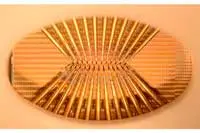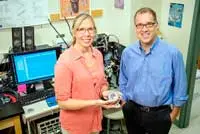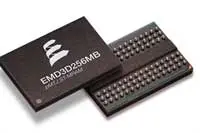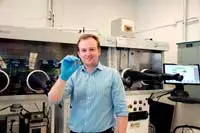Electronics News
Archive : 6 August 2016 год
 IBM scientists in Zurich have created artificial neurons to store and process data. This innovation is said to mark a step towards energy efficient, ultra-dense neuromorphic technologies for applications in cognitive computing.
IBM scientists in Zurich have created artificial neurons to store and process data. This innovation is said to mark a step towards energy efficient, ultra-dense neuromorphic technologies for applications in cognitive computing.
The artificial neurons consist of phase-change materials, including germanium antimony telluride. These materials are the basis of re-writable Blu-ray discs. However, the neurons store analogue information, not digital.
The team applied a series of electrical pulses to the artificial neurons, which resulted in the progressive crystallisation of the phase-change material, ultimately causing the neuron to fire. This is the foundation for event-based computation.
IBM fellow Evangelos Eleftheriou said: “In the past 24 months, we have discovered new memory techniques, including projected memory, stored 3 bits per cell in phase-change memory for the first time, and now are demonstrating the powerful capabilities of phase-change-based artificial neurons, which can perform various computational primitives such as data-correlation detection and unsupervised learning at high speeds using very little energy.”
Imitating the versatile computational capabilities of large populations of neurons has always been a challenge because of the required level of density and power.
Meanwhile, IBM scientists have organised hundreds of artificial neurons into populations and used them to represent fast and complex signals. The artificial neurons can sustain billions of switching cycles, which would correspond to multiple years of operation at an update frequency of 100Hz. The energy required for each neuron update was less than 5pJ and the average power less than 120µW.
The team says that even a single neuron can be used to detect patterns and discover correlations in real-time streams of event-based data. Large populations of these nanoscale neurons could also be used in neuromorphic coprocessors with co-located memory and processing units.
Author
Peggy Lee
Source: www.newelectronics.co.uk
 Research by Imperial College London suggests a new form of light could be created by binding light to a single electron in a topological insulator and combining the properties of both. According to the team, the coupled light and electron would have properties that could lead to photonics based circuits.
Research by Imperial College London suggests a new form of light could be created by binding light to a single electron in a topological insulator and combining the properties of both. According to the team, the coupled light and electron would have properties that could lead to photonics based circuits.
Dr Vincenzo Giannini said: “The results of this research will have a huge impact on the way we conceive light. Topological insulators were only discovered in the last decade, but are already providing us with new phenomena to study and new ways to explore important concepts in physics.”
In normal materials, light interacts with electrons on the surface of a material and within it. But, by using theoretical physics to model the behaviour of light and topological insulators, the researchers have found that light could interact with a single electron on the surface. This, the team believes, would create a coupling that merges some of the properties of the light and the electron.
Normally, light travels in a straight line, but when bound to the electron it would instead follow its path, tracing the surface of the material. However, Dr Giannini’s work showed that, as well as the light taking the property of the electron and circulating the particle, the electron would also take on some of the properties of the light. Instead of stopping when faced with a defect, the electron would still be able to travel onwards with the aid of light. If this could be adapted into photonics, says the team, it could create more robust circuits which are less vulnerable to disruption and physical imperfections.
Pic: Vincenzo Giannini
Author
Graham Pitcher
Source: www.newelectronics.co.uk
 Researchers from University of Illinois have developed a method to test stress and strain in battery electrodes in a move to further understand the mechanical, electrical and chemical forces within lithium-ion batteries.
Researchers from University of Illinois have developed a method to test stress and strain in battery electrodes in a move to further understand the mechanical, electrical and chemical forces within lithium-ion batteries.
According to professor Nancy Sottos, the materials in a battery cell cannot truly expand and contract as they would when unconstrained, which causes mechanical stress. “The stress and strain can actually change the way a battery functions, and usually in a negative way – like the capacity will fade, or it will cause small cracks that cause reactions you don’t expect”.
Chemistry professor, Andrew Gewirth said: “Stress and strain have been measured separately, but no one has even looked at them together before.”
The researchers have dubbed their measurement ‘electrochemical stiffness’, defined as the ratio of stress to strain.
The research has already revealed that there is a spike in stress just before the lithium is taken up by the anode.
“We didn’t expect there would be a barrier or an impediment to the lithiation process,” prof Gewirth said. “First, it shows us where the impediment is for charging. Now that we know where it is, we can work on ways to fix it. Second, it gives us a better idea of how the battery actually works.”
“These experiments are giving insight that it’s not just an electrochemical issue; it’s also a mechanical issue,” prof Sottos said. “We think we are beginning to understand some of the factors that are hindering faster battery charging.”
This may lead to batteries that charge faster and have greater capacity that could boost portable electronic devices and electric cars.
Author
Peggy Lee
Source: www.newelectronics.co.uk
Self-propelling liquid metals, developed by researchers at RMIT University in Melbourne, are said to be a critical step towards flexible and reconfigurable soft circuit systems, such as 3D electronic displays and components. Potential applications range from smart engineering to biomedicine.
As well as being malleable, any droplet of liquid metal contains a highly-conductive metallic core and an atomically thin semiconducting oxide skin – essential for making electronic circuits.
To work out how to enable liquid metal to move autonomously, Professor Kourosh Kalantar-zadeh and his group from the School of Engineering at RMIT first immersed liquid metal droplets in water.
"Putting [liquid metal] droplets in another liquid with an ionic content … can allow them to move about freely in three dimensions," Prof Kalantar-zadeh said. "We adjusted the concentrations of acid, base and salt components in water and investigated the effect. Simply tweaking the water's chemistry made the liquid metal droplets move and change shape, without any need for external mechanical, electronic or optical stimulants.
"Using this discovery, we were able to create moving objects, switches and pumps that could operate autonomously – self-propelling liquid metals driven by the composition of the surrounding fluid."
According to the professor, it may be possible to build a 3D liquid metal humanoid on demand: “Like the T-1000 Terminator but with better programming," he concluded.
Author
Peggy Lee
Source: www.newelectronics.co.uk
![]() A silicon-tin nanocomposite anode developed by researchers at the University of California Riverside (UCR) could lead to lithium-ion batteries that can be charged and discharged more times before they reach the end of their useful lives. Applications range from handheld electronic devices to electric vehicles.
A silicon-tin nanocomposite anode developed by researchers at the University of California Riverside (UCR) could lead to lithium-ion batteries that can be charged and discharged more times before they reach the end of their useful lives. Applications range from handheld electronic devices to electric vehicles.
While graphite is the material of choice for most anodes in lithium-ion batteries, its performance is a limiting factor in making better batteries. Both silicon and tin have already been investigated as high performance alternatives for graphite anodes.
Lorenzo Mangolini – an associate professor at UCR – and his team claim to have shown for the first time that combining silicon and tin into a single composite leads to improvements in battery performance. The nanocomposite is said to triple the charge capacity offered by graphite and to be stable over many charge-discharge cycles.
Mangolini said that adding tin to the silicon, rather than another conductive material such as carbon black, circumvents the low conductivity of silicon without decreasing energy storage.
"The synergistic effects between these two materials lead to batteries that exceed the performance of each of the two components alone, an improvement that is a result of the high electrical conductivity and good energy storage capacity of tin. This can be achieved with the addition of even minor amounts of tin, as small as 2% by weight."
![]()
credit: University of California Riverside
Source: www.newelectronics.co.uk
 Everspin Technologies has used the Flash Memory Summit to announce that it is shipping samples of the first memory to use perpendicular magnetic tunnel junction (pMTJ) based ST-MRAM. The 256Mbit DDR3 compatible device is said to be the highest density perpendicular ST-MRAM available commercially.
Everspin Technologies has used the Flash Memory Summit to announce that it is shipping samples of the first memory to use perpendicular magnetic tunnel junction (pMTJ) based ST-MRAM. The 256Mbit DDR3 compatible device is said to be the highest density perpendicular ST-MRAM available commercially.
Joe O’Hare, director of marketing, claimed the announcement as a breakthrough on a couple of fronts. “Not only are we sampling a 256Mbit pMTJ based device, it is also being made on a 300mm line at GlobalFoundries. Being able to manufacture this memory on a 300mm line is very exciting.”
According to Everspin, this is the third generation of its MRAM technology and the provision of DDR3 compatible interface will allow it to be designed into high performance enterprise systems.
O’Hare claimed the part offered the ‘highest write performance’. “The technology can support 1.5million IOPs,” he said, “and this shows how enterprises can apply it to speed applications. And the DDR3 interface will make it easy to design ST-MRAM into existing applications as these are already DDR3 based.” According to Everspin, the write performance is ‘100,000 times faster’ than NAND flash.
The pMTJ variant sees switching taking place perpendicularly to the plane. Benefits include scalability and lower power consumption, said O’Hare. “The approach needs less current to create the magnetic moment, allowing a higher bandwidth and faster performance.” He said the technology could scale to the 11nm node and beyond.
The 256Mbit samples have been produced on a 40nm process, but in the in plane format. When volume manufacturing starts next year, users should see a 50% reduction in die size.
Meanwhile, Everspin is now working on a 1Gbit pMTJ device with a DDR4 interface.
Author
Graham Pitcher
Source: www.newelectronics.co.uk
 An environmentally-friendly battery that stores energy in a vitamin-created plastic has been developed by a team of chemists from University of Toronto. The battery uses Flavin from vitamin B2 as the cathode.
An environmentally-friendly battery that stores energy in a vitamin-created plastic has been developed by a team of chemists from University of Toronto. The battery uses Flavin from vitamin B2 as the cathode.
"When you take something made by nature that is already complex, you end up spending less time making new material.” said Dwight Seferos, an associate professor at the University.
While bio-derived battery parts have been created previously, this is said to be the first that uses bio-derived polymers for one of the electrodes, instead of costlier, harder to process and more environmentally-harmful metals such as cobalt.
Vitamin B2's ability to be reduced and oxidised makes its well-suited for a lithium ion battery. "B2 can accept up to two electrons at a time," says Seferos. "This makes it easy to take multiple charges and have a high capacity compared to a lot of other available molecules.
"It's a pretty safe, natural compound," Seferos added. "If you wanted to, you could actually eat the source material it comes from."
While the current prototype is on the scale of a hearing aid battery, the team hopes its breakthrough could lay the groundwork for powerful, thin, flexible, and even transparent metal-free batteries that could support the next wave of consumer electronics.
Pic: Credit: Diana Tyszko/University of Toronto
Author
Peggy Lee
Source: www.newelectronics.co.uk

